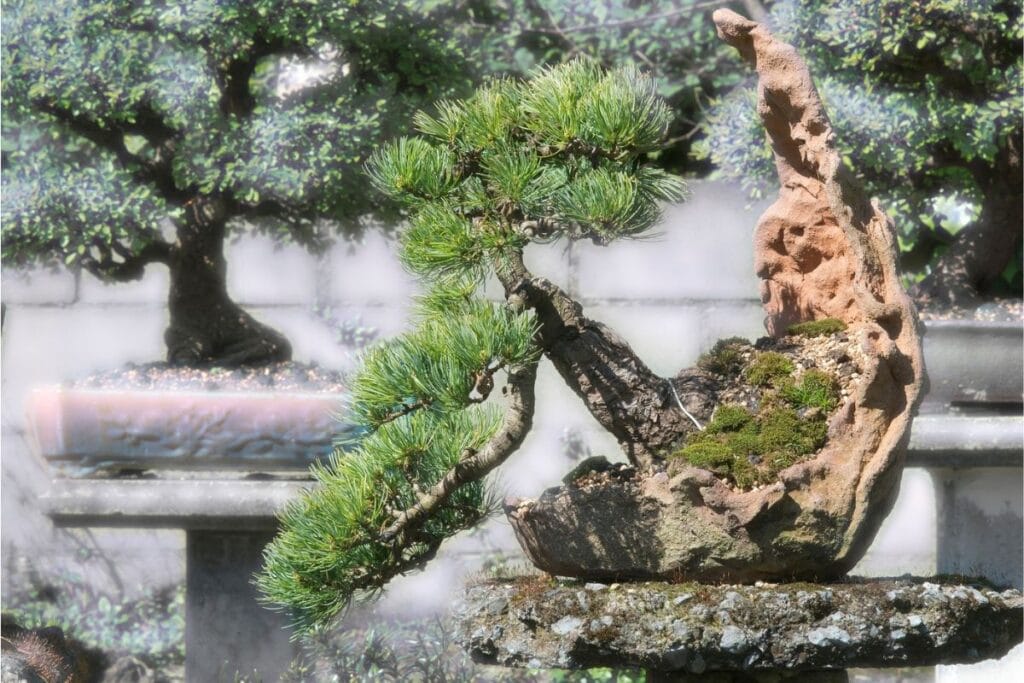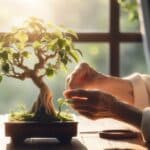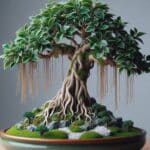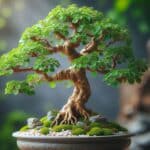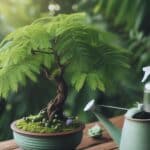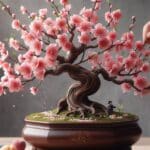It may be a tree that you think of more often as a Christmas tree, but the reality is that spruce is an evergreen coniferous tree with plenty of other uses, too.
Not only is it prized for use in woodworking, but spruce is also a popular bonsai plant. Growing up to 200 feet tall when mature, these trees can be trained to a diminutive few inches in the bonsai culture.
There are several types of spruce bonsai you can grow, including the popular Norway spruce bonsai tree, blue spruce, and the Dwarf Alberta spruce, but all of them are easy to grow. Here’s what you need to know.
Interesting Facts about Spruce Bonsai
| Height | 7-9” |
| Width | 3-5” |
| Sunlight | Full sun to partial shade (depending on species and cultivar) |
| Flowering Time Length | N/A |
| Lifespan | 40-60 years |
| Scientific Name | Picea |
Types of Spruce Bonsai Tree
Spruce trees fall into the Picea family. Here are some of the most popular types of picea bonsai trees.
Picea abies
P. abies, or three Norway spruce bonsai tree, is traditionally used as a Christmas tree and has reddish brown bark and shiny green needles. The Norway spruce bonsai tree is hardy in zones 2B through 7a, making it a good choice for northern bonsai growers. Of course, it can also be cultivated indoors.
There are several cultivars of the Norway spruce bonsai tree that can be used in bonsai, too, including P. abies albertiana ‘conica,’ P. abies ‘Echiniformis’ (a natural dwarf variety that grows slowly and produces more densely-packed foliage), P. abies ‘Little Gem,’ (prized for its tiny needles) and P. abies ‘Nidiformis.’
Some other cultivars of the Norway spruce bonsai tree to consider include:
- P. abies ‘Pumila’
- P. abies ‘Pumila Nigra’
- P. abies ‘Pygmaea’
- P. abies ‘Variegata’
Picea engelmannii
This kind of spruce is known as Blue Engelmann spruce or dwarf Alberta source. Hardy to zone 3, it has fragrant needles that smell like camphor when they are crushed. It’s great for indoor growing and also produces delicate orange cones.
The dwarf Alberta spruce is a hybrid of the Norway spruce and European spruce. The small mound size and new growth make it ideal for a bonsai tree, while the old wood provides a strong foundation for structural pruning.
Picea glauca
P. glauca, or white spruce, has blue green needles that are somewhat prickly to the touch. It is hardy in zones 2-5 and has a refreshing aroma. It’s important to note that this spruce bonsai tree does not do well in the heat.
There are several cultivars of P. glauca for you to consider as well, including:
- P. glauca ‘Albertiana conica’
- P. glauca conica (this one is very susceptible to spider mites but withstands heat and dry spells better than other bonsai options)
- P. glauca densata
Picea glehnii
This kind of spruce bonsai is known by many other names including silver fir, Edo spruce, common Ezo spruce, and Sakhalin spruce. While it’s popular in Japan, it may be harder to acquire in the United States because of export laws.
Picea jezoensis
Also known as Yezo spruce, H ondo spruce, jezo spruce, or Yeddo spruce, this type of spruce for bonsai is hardy to zone 5 and needs to be grown in somewhat shady conditions.
Picea mariana
Also known as black spruce, this species can also be found with a dwarf cultivar, ‘Nana.’ It grows in a narrow form and also comes in a weeping form. It is hardy in zones 4-7.
Picea orientalis
Known as Caucausain or Oriental spruce, this kind of spruce is perfect for bonsai because it has unique purple cones and short needles. It is hardy to zone 5 and when found growing in the wild, can grow to 50 feet or more. It’s one of the best options if you plan on using it as a bonsai specimen in a hot, humid environment.
Picea oungens
Also known as Montgomery spruce, this kind of bonsai tree has blue needles and naturally grows in a compact form, making it perfect for bonsai.
Picea pungens
You might hear this kind of spruce tree referred to as ‘River Road’ or as Colorado blue spruce. The Colorado blue spruce can grow to zone 3 and survives some of the highest altitudes.
The Colorado blue spruce s one of the most popular evergreen trees in the Northern Hemisphere? It has a distinct silver-blue foliage mass that stands out in any landscape, and its rough bark and strong branch structure make it a visually appealing tree for structural pruning and branch selection.
The cambium layer of a Colorado blue spruce is responsible for its active growth and balance energy, which is crucial during the growing season. During the early spring, when the blue spruce tree is still in the dormant stage, it can withstand freezing temperatures and cold weather.
As soon as the weather warms up, active growth begins for the blue spruce, and the tree enters its prime growing season. This is the best time to move a spruce bonsai tree into a new position in order to give it enough light exposure and ensure it receives afternoon shade and morning sun.
As late summer approaches, the Colorado blue spruce begins to slow its growth and prepare for the winter season. It is during this time that the spruce branches become a popular choice for Christmas trees due to their durability and traditional appearance.
Picea rubens
Picea rubens, or red spruce, can also grow at high altitudes and has lovely rich purple bark that turns reddish on older trees and gray at high altitudes. It has aromatic candles that smell just like apples.
Picea sitchensis
This kind of spruce is frequently referred to as Sitka spruce and is the fastest growing spruce in the world, perfect for us impatient bonsai hobbyists!
Picea torana
Picea torana, also known as the tiger-tail spruce, is a stunning addition to any garden. This beautiful tree can be found thriving in up to zone 6 of the northern hemisphere, bringing an impressive foliage mass and rough bark to any landscape.
When it comes to cultivating this tree, it’s important to consider the cambium layer – the thin layer of cells just inside the bark that is responsible for moving nutrients and water throughout the tree. Maintaining a balance of energy between the cambium layer and the rest of the tree is key to keeping your Picea torana healthy.
When it comes to outdoor placement, Picea torana prefers a location that gets enough light but also offers some afternoon shade to protect it from freezing temperatures and cold weather. For best results, position it in the morning sun to encourage active growth during the growing season.
Growing Spruce Bonsai from Seed or by Propagation
Spruce trees can be propagated both from seed and cuttings. Cuttings are best taken in the late summer.
How to Care for Spruce Bonsai
Here are some bonsai care tips you can follow:
Sunlight
Place your spruce bonsai tree in full sun during the growing season. It can tolerate either direct or indirect light. During the winter months, however, when the plant is dormant, put it in a bit of shade. If you are growing this bonsai tree outside, provide it with some protection from the frost. When its roots become frozen, it won’t be as adept at getting water to the foliage and it can thus dry out.
Watering
As soon as you notice the soil has begun to dry out, water your spruce bonsai. Avoid keeping the roots soggy but make sure adequate moisture is provided even during the winter months.
Fertilizing
You can use a solid organic fertilizer once a month or a liquid fertilizer every seven to ten days. Spruce bonsai trees benefit from fertilizers that are designed specifically to feed the leaves, usually with chelates, iron, and high levels of nitrogen to improve the color and growth of the foliage.
Potting and Repotting
Repotting your spruce bonsai should be done once every three years for newer, younger trees. For older trees, you can wait longer, usually every four or five years, since the growth will be slower. To do this, just prune the roots slightly, removing no more than a third of their growth. Use a well-draining soil mix when you put the trimmed plant in a new container.
Pruning Spruce Bonsai
Spruce bonsai has a unique whorled pattern of growth, causing several branches to grow at the exact same height on the trunk of the tree. To prune your bonsai, you should remove all but one branch. You can also pinch new shoots in the spring while they are still soft.
If you need to prune longer branches, just shorten them so they are smaller twigs near the trunk. Leave buds and needles on branches you intend to keep.
Pests and Diseases
There are several pests and diseases to which spruce bonsai is unfortunately prone. Watch out for pests like green spruce aphids, spruce spider mites, and source needle miners, along with fungal diseases like rust.
All of these are best prevented by growing your spruce bonsai indoors and following the steps listed above for caring for your plant. A healthy plant will be able to withstand disease and pest infestation with ease.
If pests and fungal diseases become too much for your tree to bear and are causing serious damage, stunted growth, or defoliation, you can use a pesticide or fungicide to get rid of them.
Where to Buy Spruce Bonsai
You can buy spruce trees for bonsai anywhere you would ordinarily purchase spruce trees for cultivation in the landscape. Shop your local tree nursery or online at your favorite bonsai specialty shop for trees that were grown from certified stock.
See more types of bonsai trees with pictures if you’re interested in growing bonsai.
References
Reference list:
1. Oregon State University Landscape Plants (n.d.). “Picea abies.” Retrieved from: https://landscapeplants.oregonstate.edu/plants/picea-abies
2. NC State Extension (n.d.). “Picea glauca ‘Conica.’” Retrieved from: https://plants.ces.ncsu.edu/plants/picea-glauca-conica/
Close
*image by picea/depositphotos

